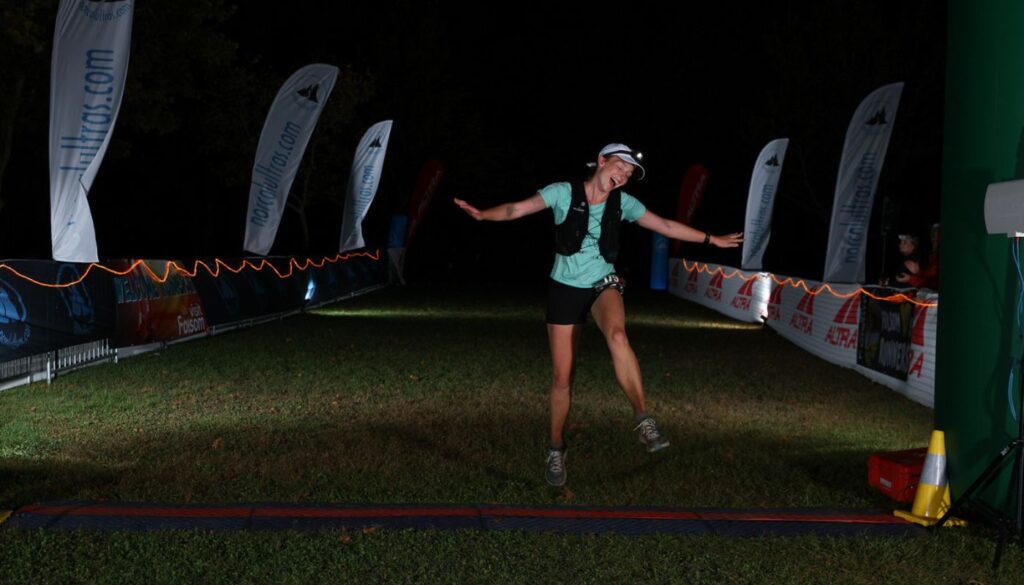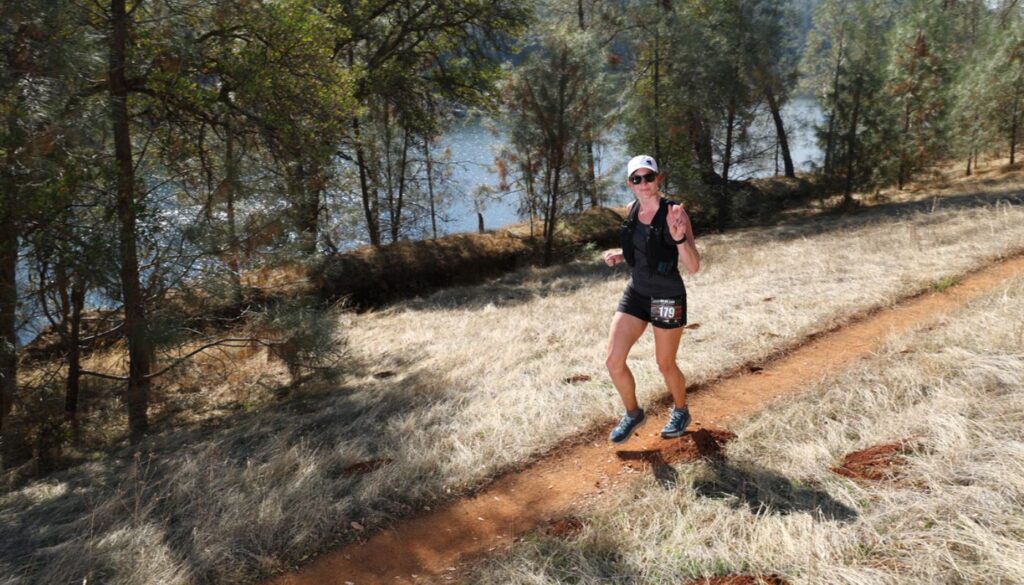Mental strength comes in all shapes and sizes.
This spectator is referencing the well-known mantra of American ultrarunner and retired U.S. Navy SEAL David Goggins. “Stay Hard” translates to “Stay Tough” in the face of adversity. In Goggins’ book, Can’t Hurt Me, he shares his incredible story of overcoming a difficult upbringing and reinforces the mindset of mental toughness, strong work ethic, and determination.
This mantra seems to have helped and motivated plenty of people in ultrarunning, which couldn’t make me happier. As a UESCA-certified ultrarunning coach, I’m always encouraging athletes to find the spark that ignites their determination. As an ultrarunner myself, however, training for my seventh 100-mile trail race, “Stay Soft” is the counter-mantra I created to keep perspective in the sport.
Running a 100-mile trail race requires a certain level of mental toughness and grit. For training, it’s especially important to be consistent and determined. Plenty of ultra athletes like the commitment of the daily grind without the guarantee of crossing a race finish line.
I deeply respect Goggins’ principles of work ethic and staying driven to complete a mission. Growing up, I observed the work ethic of my single mother who raised me on a full-time teacher’s salary while working in a restaurant on weekends to make ends meet. There is always an opportunity to remember where you came from and why you are driven to keep moving forward. In fact, my whole ultra journey has been centered around honoring my mother’s sacrifice for me. However, in my community, some runners will hold firm to “death before DNF (Did Not Finish),” implying they’d rather die than not finish a race. Here’s where my alternative mantra comes in.
At its base level, “Stay Soft” is a complement to “Stay Hard.” I believe tapping into our emotional intelligence makes us more well-rounded athletes. In a race, it could even lead to our success. In one 2011 study, which evaluated emotional states of ultrarunners in a six-day stage race, researchers concluded that although emotions varied drastically over the course of the race, emotional intelligence correlated with pleasant emotions. Any ultrarunner knows that the more confident and gratified we feel in a race, the less likely we are to drop out.
The truth is, you’ll need a bit of realism, emotional intelligence, and drive to stay well-balanced in training and one of these long race efforts. When an inevitable challenging moment pops up, you must be able to pause and assess what’s going on in the situation; emotionally, physically, and environmentally to find the best way forward.

There are situations where toughness simply doesn’t apply, and what you want doesn’t matter. Some (unfortunately) common examples in ultramarathons that can make it physically impossible to continue on include rhabdomyolysis and weather constraints. In 2023, I ran a 100-miler that was canceled due to a dangerous snowstorm mid-race. While I was able to finish before it got dangerous, many racers were pulled from the course with only a few miles to go. Aid station tents were blowing over, volunteers were freezing, yet racers were still trying to push the limits with park rangers. We are simply never tougher than Mother Nature, and we need to respect race staff and volunteers.
Alternatively, I believe there are times to bring out the “Stay Hard” mindset when you know you need to push and are safe enough to do so. My favorite example is ultrarunner and coach Joe Corcione’s alter ego, called “Lupo,” who he brings out to push harder in certain sections of his races. Most recently, Corcione brought out Lupo during the Javelina Jundred trail race, where he placed tenth male. In a recent podcast episode, he said that although he often likes to talk to other runners in his races, he focused less on talking and more on executing his laps in his planned timeframes at Javelina. With Javelina’s infamous flat and fast course, Corcione clearly strategized well. Like Corcione, we can toggle between these mindsets, knowing when to “Stay Hard” and when to “Stay Soft.” Both are tools in the ultrarunner’s arsenal.

For me, “staying soft” means staying open. I am a better athlete when I remember the adventure will be long and unknown.
I spend my 30-mile training runs deep in my emotions, unraveling challenging aspects of my week, digging into what I want to accomplish in the coming years, and assessing my personal relationships. I listen to songs that make me cry happy tears and sad tears mid-run, and I couldn’t be prouder to admit it.
During challenging moments in long runs and races, it helps me to remember how lucky I am to be traversing new land, often beautiful, panoramic landscapes. I remember that a body that allows me to move for around 20 hours is one to be treasured and that I’m showing up for a Colleen that once wasn’t as strong. I find peace in the cool evening miles amongst the trees, joy in watching other racers find a second wind after seeing their family at an aid station, and purpose in the chance to spend time with my own mind in the wilderness.
The way I’ve described it to my athletes is “discovering the possibility of magic,” as cheesy as it sounds. Staying open to the possibility of magic means staying open to all the greatness we can accomplish, open to seeing and feeling what it’s like to push our bodies to their limits in nature.
Last winter, there was one run I needed to get in, but I was only able to run at night and in freezing temps. My mind and body dreaded the thought, but there was a piece of me that remembered that possibility of discovering something new about myself on the run. Within the first mile, I was shocked to discover that the stars were the brightest I’d ever seen them in Boulder, and had I not given that run a chance, I wouldn’t have gotten the boost of joy and energy those night miles. It was one of my fastest easy pace runs in that training block, and I credit it all to staying open to “the magic.”

As humans, we’re adaptable and multifaceted. Life’s seasons demand different approaches, and finding the right mindset for each moment is key.
Through introducing “stay soft”, my goal is to show that there is a balance to being tough; you are not weak for needing rest. Nothing in nature blooms all year, and without periods of rest, we can’t show up for the times we need to push. At the same time, learning how to push ourselves to the limit and sometimes beyond teaches us what we are capable of. We just have to remember we are human, not machines.
In a world often divided, gentleness fosters connection and understanding. We’re not running our own races in isolation; we’re part of a collective journey, striving for shared goals. Strength lies in recognizing this shared humanity, showing up for ourselves and others, and embracing the multitudes we contain.
Be soft.
Do not let the world make you hard.
Do not let the pain make you hate.
Do not let the bitterness steal your sweetness.
Take pride that even though the rest of the world may disagree,
you still believe it to be a beautiful place. ~Iain Thomas
A well-written article Colleen. I’ve always liked the idea of “stay flexible’ as an alternative to stay hard.
Great article. Ultras should not be life & death issues. I run -walk in races. As long as they are fun, I will continue. This article really hits home.